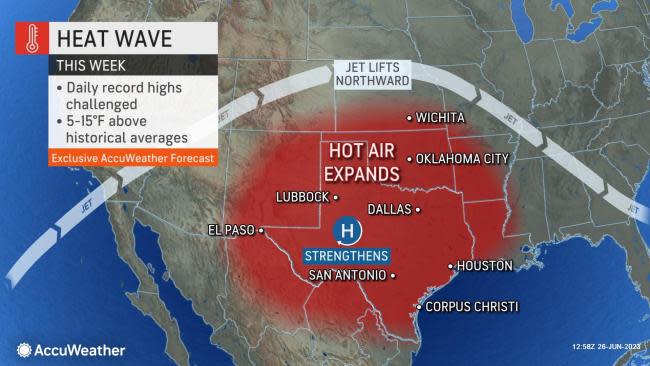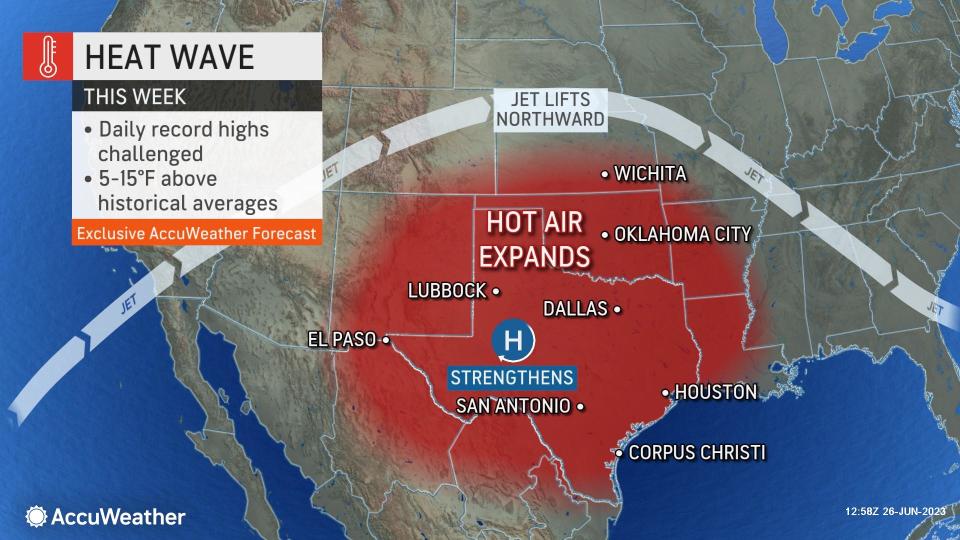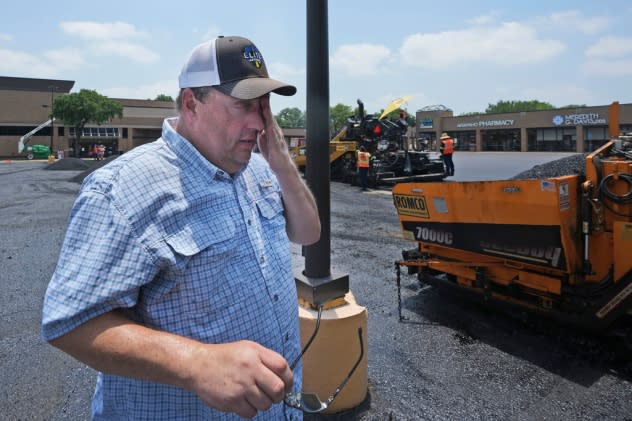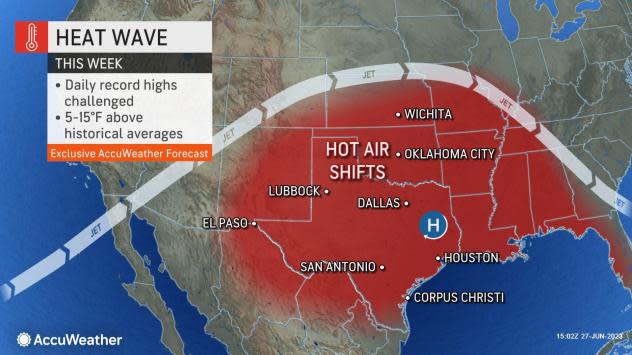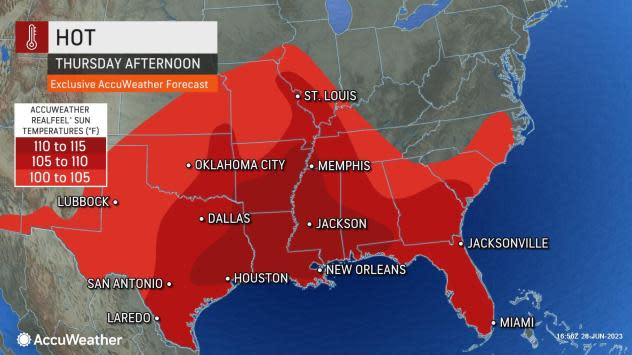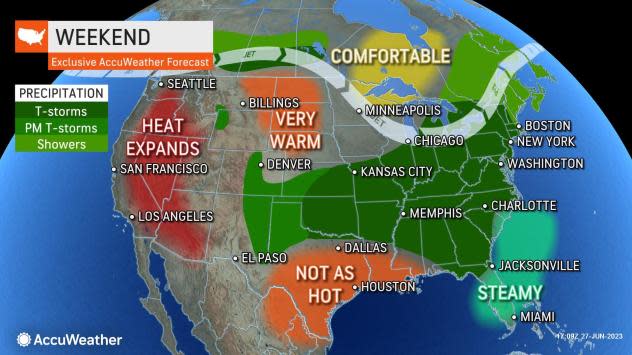Deadly heat roasts Texas as temperatures top triple digits
Deadly, record-breaking heat has enveloped the south-central United States this month, and AccuWeather forecasters say several more days of scorching conditions are in the forecast before some relief potentially arrives by the weekend.
Temperatures began to reach levels well above the historical average over a week ago across the southern U.S., with some of the worst conditions in recent days centered on Texas. Dangerous heat has left many folks sweltering and trying to find ways to keep cool, while it has turned life-threatening for others.
 |
Standing in the mid-afternoon heat, James Hand wipes sweat from his face while overseeing a parking lot asphalt resurfacing job in Richardson, Texas, Tuesday, June 20, 2023. According to Hand, the asphalt has a temperature of 250-300 degrees as it is applied to the surface. |
Late last week, the heat claimed two victims in Big Bend National Park, located in the western portion of Texas, near the border with Mexico.
A 31-year-old man and his 14-year-old stepson succumbed to the heat on Friday, June 23, while attempting to hike the Marufo Vega Trail, according to a press release from the National Park Service (NPS).
This trail is located within extremely rugged desert terrain and cuts into the hottest part of Big Bend National Park. Temperatures at the time were near 119 F in the area, according to the NPS.
The all-time high-temperature record in Texas of 120 F has been in place since Aug. 12, 1936.
Elsewhere across the state, cities like Austin and San Antonio eclipsed the triple-digit mark for the first time this year back on June 16 and have since recorded multiple additional days in excess of 100 F.
In McAllen, Texas, the city recorded its first 100-degree-Fahrenheit reading of the year on June 13, and each day since has had a high temperature above the century mark. As of June 28, McAllen has had 16 days in a row of high temperatures at or above 100 F.
 |
"A northward bulge in the jet stream across the Central states has allowed persistent hot air to push northward from Mexico and expand across parts of Texas, New Mexico, Oklahoma, southern Kansas, Arkansas and Louisiana," explained AccuWeather Meteorologist Alyssa Glenny.
This pattern, sometimes known as a heat dome, is responsible for the recent searing heat. Due to several atmospheric factors, the heat dome has remained stubbornly stuck in place, allowing areas caught under it to bake to worsening levels each day.
• Have the app? Unlock AccuWeather Alerts™ with Premium+
"Cities across northern and eastern Texas, such as Tyler, typically observe high temperatures in the lower to middle 90s F during the last week of June but are forecast to approach 100 through Saturday," said Smithmyer.
Dallas recorded its first triple-digit temperature of the year on Sunday when the mercury climbed to 101 F. The city typically reaches that benchmark right around Independence Day. As the core of the heat expands across eastern Texas, Dallas will have to contend with high temperatures in the triple digits for much of this week.
 |
AccuWeather RealFeel® Sun Temperatures reached between 105-115 F from central Texas to parts of the Gulf Coast on Tuesday and will continue to soar 5-15 degrees above 100 F through the end of the week.
"Intense sunshine and very dry soil often lead to a temperature feedback loop that makes each day hotter than the last," explained AccuWeather Senior Meteorologist Courtney Travis.
AccuWeather National Reporter Bill Wadell was in Texas over the weekend to see how residents were dealing with the brutal heat.
"[The heat] feels aggressive," Austin resident Juan Sepeda told Wadell. "We may have made Mother Nature mad, and she's decided to turn up the heat on us."
Intense, prolonged heat typically leads to a much higher demand for power than normal, as folks attempt to stay cool with the use of air conditioning or fans. This increased demand can put a strain on power grids.
Sepeda, a Texas native, says that issues with the state's power grid during the unrelenting heat have already hit home.
"We've already felt the ramifications. We've seen blackouts and brownouts and a lot of situations that result in our power being cut off."
Without the proper resources to cool down, heat waves can become deadly quickly. This is especially true for vulnerable age groups like children or the elderly.
AccuWeather forecasters expect the pattern keeping stifling heat in place to begin to break down by the weekend. Temperatures are still likely to remain a few degrees above historical averages but not nearly at the level set to unfold this week.
A southward dip in the jet stream over the central U.S. will prevent the worst of the heat from moving into the areas that have been hardest hit since mid-June.
 |
By Saturday, temperatures in places like Dallas may finally sink back into the 90s, rather than the 100s.
However, as the calendar flips from June to July, historical average temperatures across the region will be on the rise as the U.S. approaches its hottest time of the year.
Want next-level safety, ad-free? Unlock advanced, hyperlocal severe weather alerts when you subscribe to Premium+ on the AccuWeather app. AccuWeather Alerts™ are prompted by our expert meteorologists who monitor and analyze dangerous weather risks 24/7 to keep you and your family safer.
